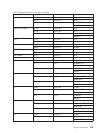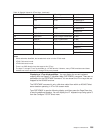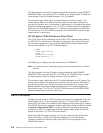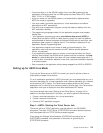Certain AS/400 applications also lock the 5250 keyboard and turn on the 5250
input-inhibited light. The user is then required to press the Error Reset key before
the keyboard is unlocked. For VTxxx sessions, the locking of the 5250 keyboard
causes a bell to sound on the VTxxx terminal whenever a key is pressed. To unlock
the keyboard, the VTxxx key that is mapped to the Error Reset key must be
pressed. In the default VTxxx keyboard map, the key CTL-R is mapped to the Error
Reset key.
Display Screens and VTxxx Support
When VTxxx support is negotiated, the Telnet server transmits screens that are a
maximum of 24 rows by 80 columns. The VTxxx client system sees these screens
in much the same way as they appear on a 5251 Model 11 workstation. However,
there are some differences.
v A 5251 display has indicator lights on the right side that indicate:
– System Available
– Message Waiting
– Keyboard Shift
– Insert Mode
– Input-Inhibited
The VTxxx server support emulates the System Available, Message Waiting,
Insert Mode, and Input-Inhibited lights by putting an asterisk in column 80 of rows
9, 11, 13, or 15, respectively. When an asterisk is displayed, the asterisk
overwrites the character that was previously displayed at that screen location. By
default, the VTxxx server does not display the indicator lights. You can enable or
disable these indicators by typing the key sequence that is mapped to the toggle
indicator lights function. The default key sequence for this function is ESC-T.
Note: When using a VTxxx client to attach to the AS/400 Telnet, note that the
Insert Mode and the Input-Inhibited lights may not always display as
described above. 5250 supports the attachment as a local function while
the VTxxx has no such facility. The System Available and Message
Waiting indicators, however, will display correctly.
v A 5251 display supports a screen attribute known as a column separator. The
column separator is a vertical line displayed between characters. This line does
not take up a character space. The VTxxx does not support such an attribute. If
an AS/400 application generates a screen that uses the column separator
attribute, that screen is displayed on the VTxxx client system with the column
separator mapped to the VTxxx underline attribute.
VT220 Control Characters
When VT220 8-bit emulation is negotiated, the range of characters X’80’ - X’9F’ are
protected as C1 control characters as architecturally defined in DEC
VT220
Programmer Reference Manual
This may result in the succeeding characters in a
data stream being interpreted as data in relation to these characters. If VT220 7-bit
or VT100 is negotiated, then the full range of characters from X’80’ - X’FF’ is
available for character translation. X’80 - X’9F’
must
be interpreted as C1 control
characters in VT220 8-bit control mode only.
This has particular relevance to NLS support, as several non-English languages use
these values for language specific characters, and so in these cases, the VT220
8-bit emulation may not function as anticipated.
208 OS/400 TCP/IP Configuration and Reference V4R4


















